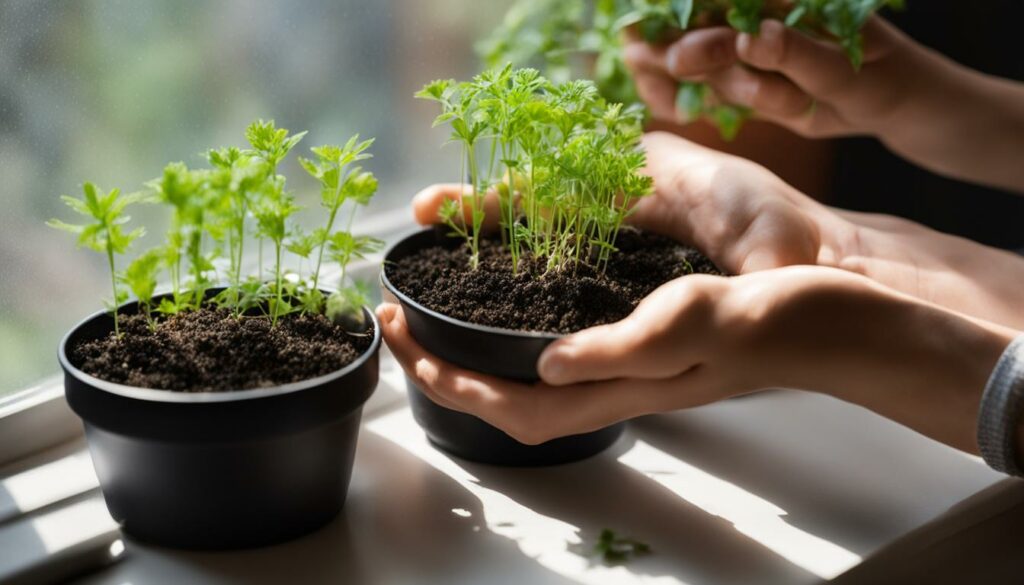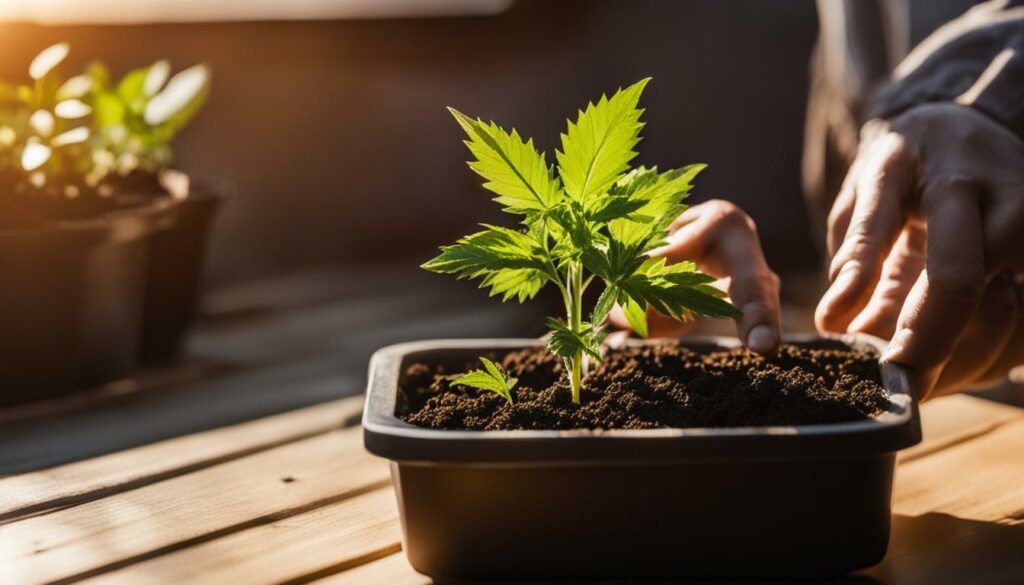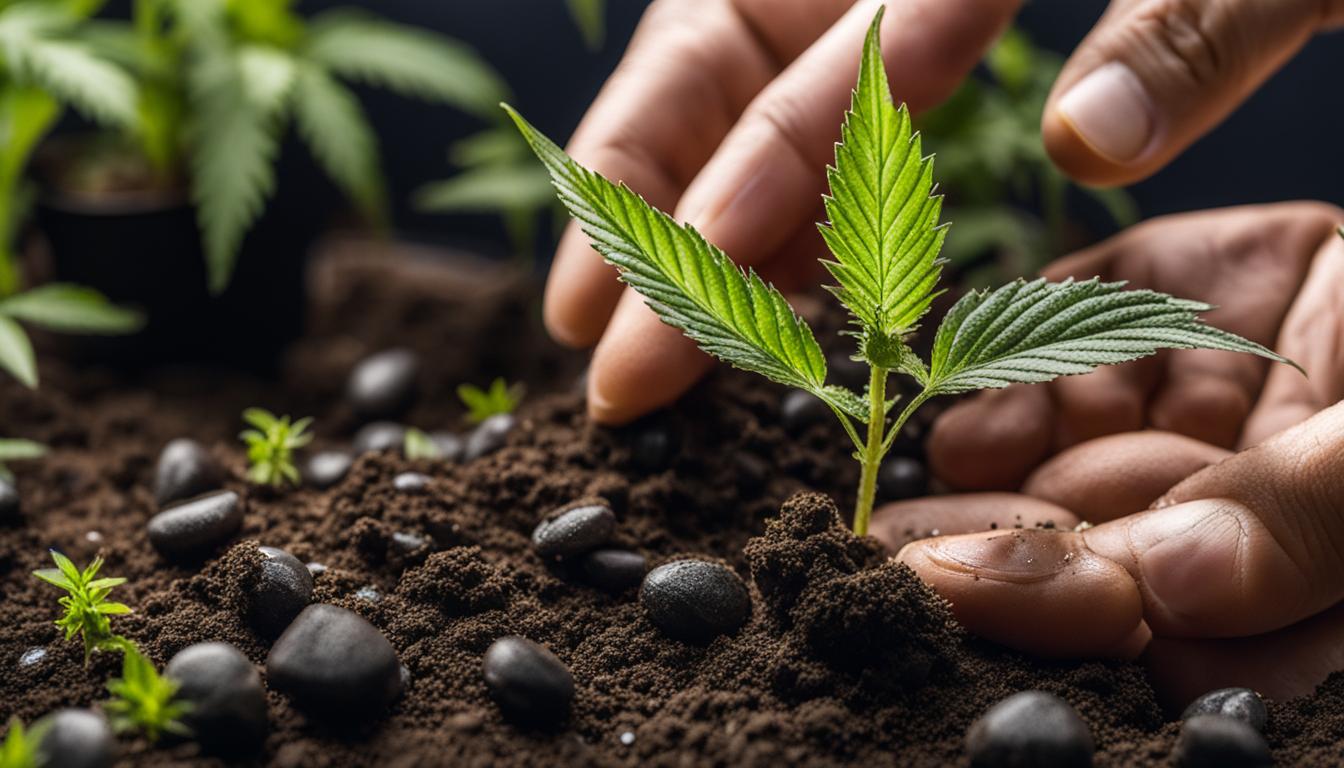Welcome to our comprehensive guide on planting germinated weed seeds! In this article, we will walk you through the essential steps for successfully germinating and planting weed seeds. Whether you’re a seasoned grower or just starting out, these techniques will help you achieve healthy and thriving plants.
Germinating cannabis seeds before planting is a crucial step that increases success rates and ensures healthier plants. By following the proper steps and techniques, you can significantly reduce the risk of issues like damping off and suffocation.
But why should you germinate weed seeds before planting? Well, it allows you to confirm the viability of the seeds and provide them with the best possible start in the growing process. It also eliminates the risks associated with overly moist or dry mediums, giving your seeds the optimal conditions they need to flourish.
So, are you ready to learn the steps to successfully plant germinated weed seeds? Let’s dive in!
Benefits of Germinating Weed Seeds Before Planting
Germinating weed seeds before planting offers several benefits. By following germination techniques and best practices, growers can set themselves up for success right from the start. Here are some key advantages of germinating weed seeds before planting:
- Increased Success Rate: Germination allows growers to confirm the viability of the seeds before investing time and resources into planting. This helps prevent disappointment and ensures a higher success rate.
- Controlled Conditions: Germinating seeds before planting provides growers with the opportunity to create ideal conditions for the awakening seed. This helps prevent issues like overly moist or dry medium, suffocation, and damage from excavation.
- Healthy Seedlings: Germination gives seeds the best start by ensuring they have access to the right amount of moisture, oxygen, and warmth. This promotes healthy root development and overall plant growth.
- Time and Resource Efficiency: By germinating seeds first, growers can focus their efforts on viable seeds, saving time, and resources on non-viable ones.
Overall, germinating weed seeds before planting is a recommended practice that sets the foundation for successful cannabis cultivation. By providing optimal conditions and confirming seed viability, growers can maximize their chances of growing healthy and productive plants.
Expert Advice on Planting Germinated Marijuana Seeds
“Germinating weed seeds before planting is a crucial step in the cultivation process. It gives the seeds the best chance to grow into healthy and robust plants. By providing a controlled environment during germination, growers can avoid unnecessary risks and increase their success rate.”
– Jane Green, Cannabis Cultivation Expert
As advised by experts like Jane Green, following germinated seed planting tips and best practices is key to achieving optimal results. Taking the time to germinate seeds before planting allows growers to ensure the best conditions for their cannabis plants, leading to healthier and more productive yields.
| Benefits of Germinating Weed Seeds Before Planting | Expert Advice on Germinated Seed Planting |
|---|---|
| Increased Success Rate | Crucial Step in Cultivation Process |
| Controlled Conditions | Avoid Unnecessary Risks |
| Healthy Seedlings | Increase Success Rate |
| Time and Resource Efficiency | Optimal Results |
By understanding the benefits of germinating weed seeds before planting and heeding expert advice, growers can set themselves on the path to successful and rewarding cannabis cultivation.
When to Plant Germinated Weed Seeds
Knowing the right time to plant germinated weed seeds is crucial for their successful growth. It’s important to wait until the taproot becomes visible, which typically takes about 1-2 days after germination. At this stage, the taproot should be approximately half an inch in length. Planting the seedlings at this point ensures that they have enough energy to break through the soil and begin their journey towards becoming healthy plants.
It’s worth noting that planting germinated seeds too early or too late can hinder their growth. If planted too early, the seedlings may struggle to emerge, leading to damaged cotyledons and potential stunting. On the other hand, if planted too late, the seedlings may become leggy and weak while trying to reach the surface.
To avoid these issues, closely monitor the germination process and plant the seeds as soon as the taproot emerges. This will give your germinated seeds the best chance of establishing themselves and thriving in their new environment.

Table: Comparison of Germinated Seed Planting Times
| Timing | Advantages | Disadvantages |
|---|---|---|
| Planting too early | – Higher chance of successful emergence | – Risk of damaged cotyledons |
| Planting at the right time | – Healthy seedling development | – None |
| Planting too late | – Reduced risk of damage during emergence | – Seedlings may become leggy and weak |
By planting germinated weed seeds at the optimal time, you give them the best chance of thriving and developing into healthy, robust plants. Remember to closely observe the germination process and act promptly when the taproot becomes visible. This will ensure a successful start to your cannabis cultivation journey.
Step-by-Step Guide to Planting Germinated Weed Seeds
Once your weed seeds have successfully germinated, it’s time to plant them and give them the best start in their growing journey. Follow these steps to ensure successful planting of germinated weed seeds:
- Prepare the growing medium: Fill your pots or containers with a suitable growing medium, such as a mix of potting soil, perlite, and coco coir. Ensure the medium is well-draining and rich in nutrients.
- Create a hole: Make a small hole in the center of the growing medium, about half an inch deep. You can use your finger or a pencil to create the hole.
- Place the germinated seed: Gently place the germinated seed into the hole, ensuring that the taproot is facing downwards. Be careful not to damage the delicate root.
- Cover the seed: Lightly cover the seed with a thin layer of the growing medium. Avoid compacting the soil too much to allow the seedling to push through easily.
- Water the seedling: After planting, give the seedling a gentle watering with a spray bottle or a fine-mist sprayer. Avoid overwatering, as it can lead to damping off or other issues.
- Provide the right conditions: Place the pots or containers in a warm and well-lit area, such as under grow lights or near a sunny window. Maintain a temperature of around 70-80°F (21-27°C) and a humidity level of 60-70%.
By following these steps, you are laying the foundation for successful germination and healthy growth of your weed seeds. Remember to monitor the moisture levels of the growing medium and adjust watering accordingly to prevent over or underwatering. With proper care and attention, your germinated weed seeds will soon develop into vigorous seedlings ready to flourish.

Expert Tip:
“To prevent any shock to the germinated seedling, make sure to handle it gently during the planting process. Avoid excessive pressure on the delicate stem or root, as it can cause damage and hinder growth. Treat your seedlings with care, and they will reward you with healthy growth.”
Next Steps After Planting Germinated Weed Seeds
Once you have planted your germinated weed seeds, it is important to provide them with the proper care and attention to ensure their healthy growth and development. Nurturing weed seedlings requires some essential steps to create the ideal environment for their growth.
1. Watering
One of the most critical aspects of caring for germinated weed seeds is watering. It is important to maintain a balance, ensuring that the soil remains moist but not overly saturated. Overwatering can lead to root rot and other issues, while underwatering can cause the seedlings to dry out and hinder their growth. A general guideline is to water the seedlings when the top inch of soil feels dry to the touch.
2. Light Exposure
Proper light exposure is vital for the healthy development of weed seedlings. During the early stages, it is recommended to provide them with 18-24 hours of light per day. This can be achieved using fluorescent grow lights or LED lights specifically designed for seedlings. As the seedlings grow, you can gradually reduce the light exposure to 12-16 hours per day.
3. Environmental Conditions
Creating the right environmental conditions is crucial for nurturing weed seedlings. Maintain a temperature range of 70-85°F (21-29°C) during the day and slightly cooler temperatures of 65-75°F (18-24°C) at night. Adequate humidity levels of around 50-70% will help prevent the seedlings from drying out. Using a humidity dome or a humidifier can assist in maintaining the desired humidity levels.
Remember to monitor the progress of your seedlings closely and make adjustments as necessary. By providing proper care and attention, you can ensure the healthy growth of your germinated weed seeds and set the stage for a successful cannabis garden.

Best Practices for Growing Weed from Germinated Seeds
Growing weed from germinated seeds requires careful attention and a few key techniques to ensure successful cultivation. By following these best practices, you can maximize your chances of growing healthy, robust plants and achieving a bountiful harvest.
1. Provide Proper Nutrition
Nutrition is essential for the growth and development of weed plants. During the vegetative stage, plants require higher levels of nitrogen to support leaf and stem growth. As the plants transition to the flowering stage, phosphorus and potassium become more important for promoting flower development and resin production.
Using a high-quality cannabis-specific fertilizer can ensure your plants receive the right balance of nutrients at each stage. Be sure to follow the manufacturer’s instructions and avoid overfeeding, as this can lead to nutrient burn and other issues.
2. Use Appropriate Lighting
Proper lighting is crucial for the successful growth of weed plants. During the vegetative stage, plants benefit from high-intensity discharge (HID) lights, such as metal halide (MH) or high-pressure sodium (HPS) lamps. These provide the full spectrum of light needed for robust growth.
In the flowering stage, many growers switch to LED grow lights, which offer energy-efficient operation and the ability to customize the light spectrum for optimal flower development. Whichever lighting option you choose, ensure that plants receive the recommended amount of light each day for healthy growth.
3. Maintain Optimal Temperature and Humidity Levels
Weed plants thrive in specific temperature and humidity ranges. During the vegetative stage, aim for temperatures between 70-85°F (21-29°C) and humidity levels around 40-70%. Lower temperatures can slow growth, while higher temperatures increase the risk of humidity-related issues like mold or mildew.
In the flowering stage, slightly lower the temperature to around 65-80°F (18-27°C) and maintain humidity levels between 40-50% to prevent bud rot. Regularly monitor and adjust temperature and humidity levels to create a stable environment for your plants.
| Best Practices for Growing Weed from Germinated Seeds | Summary |
|---|---|
| Provide proper nutrition | Use a cannabis-specific fertilizer and follow the recommended feeding schedule. |
| Use appropriate lighting | Use high-intensity discharge lights during the vegetative stage and LED grow lights during flowering. |
| Maintain optimal temperature and humidity levels | Keep temperatures and humidity within the ideal ranges for each stage of growth. |
By following these best practices, you can cultivate healthy, thriving weed plants from germinated seeds. Remember to monitor your plants regularly, make adjustments as needed, and provide them with the care and attention they need to flourish.

Conclusion
Planting germinated weed seeds is an essential step in the cannabis cultivation process. By germinating the seeds before planting, growers can increase their chances of success and ensure healthier plants. This comprehensive guide has provided you with the necessary knowledge and techniques to confidently navigate the germination and planting process.
Remember, germinating weed seeds before planting offers numerous benefits. It allows you to ensure the viability of the seeds, create optimal conditions for growth, and reduce the risk of issues like damping off. By following the step-by-step guide and best practices outlined in this article, you can set yourself up for a thriving cannabis garden.
As your germinated weed seeds grow into seedlings, it’s crucial to provide them with proper care and attention. Watering them regularly, adjusting light exposure, and maintaining the right environmental conditions will help support healthy development. With consistent monitoring and adjustments, you can ensure your plants continue to flourish.
In conclusion, this germinated marijuana seed planting guide has equipped you with the knowledge and techniques to successfully germinate and plant weed seeds. By following these guidelines and nurturing your plants with care, you’re well on your way to a successful cannabis cultivation journey.
FAQ
Why is it important to germinate weed seeds before planting?
Germinating weed seeds before planting ensures higher success rates and healthier plants. It reduces the risk of issues like damping off, suffocation, and impatience. Germination also allows growers to confirm the viability of the seeds before investing time and resources into planting.
When can germinated weed seeds be planted?
Germinated weed seeds can be planted as soon as the taproot becomes visible, which usually takes about 1-2 days after germination. The taproot should be around half an inch in length.
What are the steps to plant germinated weed seeds?
After germinating weed seeds, the steps to plant them are as follows:
- Prepare the growing medium
- Create a small hole in the medium
- Gently place the germinated seed in the hole
- Cover the seed with a thin layer of the medium
- Water the newly planted seed
How should germinated weed seeds be cared for after planting?
After planting germinated weed seeds, it is important to provide them with proper care, including regular watering, adjusting light exposure, and ensuring proper environmental conditions.
What are the best practices for growing weed from germinated seeds?
To ensure successful growth from germinated seeds, it is important to follow best practices such as providing proper nutrition, using appropriate lighting, maintaining optimal temperature and humidity levels, and preventing issues like overwatering or nutrient burn. Regular monitoring and adjustments are necessary to support healthy plant development.





